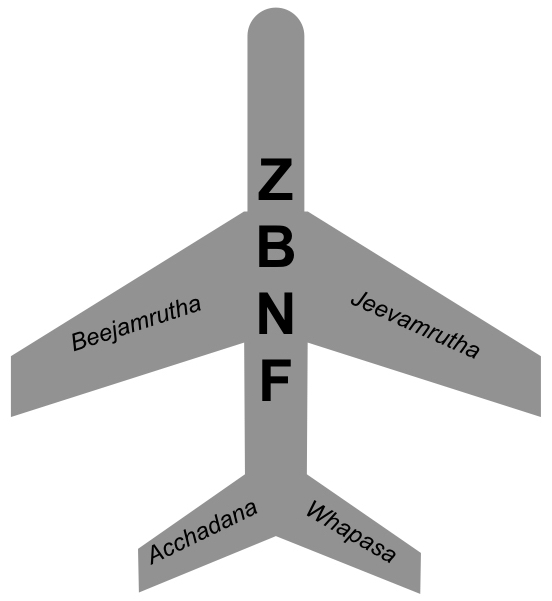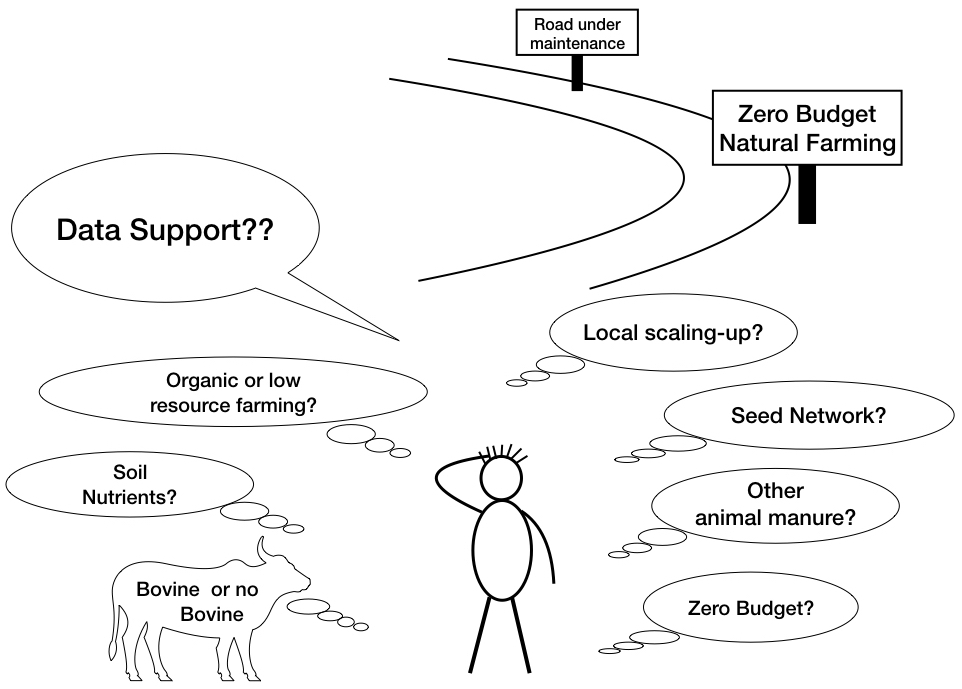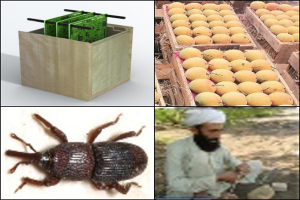Zero Budget Natural Farming or ZBNF is a newly hatched baby aka agricultural practice that has become enormously popular in recent decades and embraced by a million farmers till now. It is currently taking shape of a much larger-scale agricultural mass movement, perhaps on the way to become an institution (Khadse et al. 2017). Even it has received the applause and encouragement at the government level (Pandey 2019) and being advocated and implemented widely with the active financial thrust (RySS 2018a).
The father figure spearheading ZBNF is Mr. Subhash Palekar, an agriculturalist who set the exercise in motion in the later part of the twentieth century. He proposes a method of natural farming that divorces the application of costly agrochemicals, fertilizers, or pesticides, depending less on external inputs, thus freeing the farmers from huge investment incurred in farming activities; in that way, it claims to rely on a minimal budget or zero budget as opposed to high-input agriculture. The zero budget which may not be zero in true sense since a farmer has to invest on preparing Jeevamrutha or fermented microbial culture, rather implies a drastic reduction in input cost and compensating the same through raising income through early inter-crops. Although ZBNF attempts to create its own identity and marks its USP carefully it hinges on the broader agroecological principles that underlie many agricultural overhaul experiments worldwide. However, Mr. Palekar, later on, disowned ZBNF and rechristened it as ‘SPNF’ or Subhash Palekar Natural Farming. He seems to be a vehement opposer of organic farming and openly disclosed precarious statements equating it with an ‘atom bomb’ (Arya 2019). ZBNF and its siblings along with their creator, therefore, have caused a lot of furor and unleashed narratives and counter-narratives on various fronts.
I presume this to be the high time when the podium is at perfect storm when commentators, policy-makers, activists, scientists locked horns over ZBNF (Bharucha et al. 2020; Khadse et al. 2017; Khadse and Rosset, 2019; Kuruganti, 2019; Rao 2019; Saldanha 2018; Smith et al. 2020). The time is also ripe for a discussion on the practice of ZBNF, looking it through a critical lens. Here, my purpose is to revisit some of the points made by many previous authors and elaborate them finally leading to concluding remarks. So, before we embark on this conversation, let us look at ZBNF and its foundation pillars. This is said to a set of farming methods that rest on the four pillars of ZNBF (FAO, 2019):
- Jeevamrutha or fermented microbial culture to provide nutrients by promoting the activity of
 microbiota in the soil. Consisting of cow dung, aged cow urine, jaggery, pulse flour, water, and soil, the aerobic and anaerobic bacteria present in the cow dung and urine multiply as they consume organic ingredients. A handful of soil acts as inoculate of native species of microbes and organisms.
microbiota in the soil. Consisting of cow dung, aged cow urine, jaggery, pulse flour, water, and soil, the aerobic and anaerobic bacteria present in the cow dung and urine multiply as they consume organic ingredients. A handful of soil acts as inoculate of native species of microbes and organisms. - Beejamrutha or seed treatment mixture is like jeevamrutha, i.e., local cow dung (a powerful natural fungicide), and cow urine (a strong anti-bacterial liquid), lime, soil. It is applied to seeds, seedlings or any planting material to protect young roots from fungus, and soil- or seed-borne diseases that commonly affect plants in monsoon period.
- Acchadana or Mulching can be achieved using soil mulch (protects topsoil during cultivation and does not destroy) or straw mulch (from dried biomass of previous years’ crops or dead material remains of plants or animals). These promote aeration and water retention in the soil as well as enrich by adding dry organic material that decomposes to form humus through the activity of the soil biota which is activated by microbial cultures.
- Whapasa or moisture is the state that claims to have both air and water present in the soil, and thus encouraged irrigation only at noon in alternate furrows that may cause a significant decline in water requirement. It also incorporates other elements, i.e., intercropping to compensate the cost incurred, contours and bunds to preserve rainwater, local species of earthworms and cow dung.
Now discussing the complex topic, I shall opportunistically dwell more on some issues and leave others out; it is not a fully developed technical review in its nature but a selective analysis to revisit some aspects to write a popular narrative. This has become crucial since the three important studies have cropped up quite recently, one providing with much-needed data support to bolster the claim (Bharucha et al. 2020) and the other on the trajectory and institutionalization of ZBNF (Khadse and Rosset 2019). These are succeeded by a recent article by Smith et al. (2020) that critically analyzed the primary foundations of ZBNF in light of scientific data and understanding.
Loss of Soil quality – recharge with lost nutrients
Throughout the past centuries, agricultural fields almost all over the world have experienced a severe loss of soil nutrients, the rate accelerated with the intensification led by industrial agriculture with the Green Revolution at the helm (Jones et al. 2013). There are other factors co-acted with the intensification, such as metabolic rift (Clark and Foster 2013). On the other hand, indiscriminate use of agrochemicals (be it chemical fertilizers or pesticides) has also caused water contamination with nitrate and phosphate, changed soil pH, and reduced nutrients (Singh 2000). So, the primary challenge remains with the rejuvenation of the soil which is supposed to be dealt with the application of Jeevamrutha. It is claimed to enhance microbial activities manifold, reduce soil degradation, and make organic matter available to the soil which improves soil health. However, the actual demand for organic matter could not be met by restricted external input in the form of Jeevamrutha. In effect, the yield gain could be varied, for instance, even with maximum potential nitrogen availability resulting from the action of Jeevamrutha, it may actually fall far short of the required nitrogen demand as predicted from the national average; so, while the low-input farmer may still manage to employ Jeevamrutha, high-input system may suffer yield loss (Smith et al. 2020). It further implies that local trial and manipulation to sustain yield is highly desired prior to large-scale adoption of the practice.
There are other constraints as well, e.g., how to source the various components of Jeevamrutha importantly, the cow manure and urine (specifically from the indigenous variety, Bos indicus) since indigenous breeds have drastically disappeared from the farmers’ house in the last decades because of a variety of reasons (Katiyar and Layak 2019). So, at the outset, it is necessary to ensure easy procurement of the essential components that may not be as good as it appears in theory. Pertinently it is also a high time to divorce ‘cow entanglement’ that tends to eclipse the adoption and effectiveness of ZBNF in terms of soil rejuvenation. Besides, it is also necessary to embrace the other types of manure from a much-diverse livestock pool of India, that will also ensure the usage of the local resource pool more efficiently. Next in this process is the step to gain an understanding of the rate of manure application for specific field size, i.e., local manipulation. Therefore, it is essential to isolate the exercise of ZBNF from unrealistic claims and to debunk the manure myths that bloomed with ZBNF (Ramakumar and Arjun 2019).
Seeds network
For generations, the farmers have been saving their seeds for raising next cycles of crops that enables farmers to retain the control over their seeds and thereby keeping the seed network alive. Conserving and using seeds, selection for subsequent phases, exchanging are the essential components that constitute seed networks. The indigenous seed networks are the lifelines of self-reliance, food sovereignty, and deeply linked to the goals of sustainable agriculture (Coomes et al. 2015; Pautasso et al. 2013). ZBNF does not openly endorse the importance of native seeds just like it advocates vehemently for native breeds of cows. A strong mandate for the use of native seeds, their conservation, exchange, and promotion on this ground would be stimulating to take the movement further and align with the notion of sustainability. It would serve a couple of intertwined purposes, one, it would widely encourage small-scale local seed saving initiative by farmers or their peer-groups and conserve, use, and manage indigenous crop genetic diversity; also, it would further reduce the production cost to a significant degree when seeds are not to be bought in every cultivating season. Second, it could also seal the holes through which corporation-sold seeds can get an entry that has already intruded widely in rural India and are now posing a great threat to local crop diversity and severing the seed sovereignty.
Not one-size fit all, we need local modification or scale-up
The practice of ZBNF mostly adheres to the tenets of agroecology though not openly recognizing it. It emblematizes an inclusive term, but in the years come by the culture requires to be scaled-up to suit various agro-ecosystems of India or elsewhere; which is now largely restricted to the states of Andhra Pradesh, Karnataka, and Maharashtra. It is essential since India is a mega-diverse country concerning its climatic condition, edaphic factors, water availability, crop package, the same has been reflected in its diverse agricultural systems that tend to vary greatly; so, a one-size-fits-all approach may not only be suitable for successful implementation of ZBNF, it could be futile as well. To disseminate it further from its primary foci of activity, it desperately needs local scale diversification and optimization to address the constraints faced by local agricultural systems. That may appear as a primary impediment for its widespread adoption. A definite road-map to tackle the challenge is thus the need of the hour.
For example, water is the limiting factor in any kind of agriculture, irrigated, or rainfed. In the irrigated field, the demand is met by water canal networks, shallow-pump, or sourced from nearest water bodies, annual or perennial. While rainfed farmers are entirely at the mercy of seasonal rains. ZBNF though tells about water harvesting trenches or creating bunds but has not explicitly mentioned how these could be capable of meeting the water requirement locally because water demand so widely varies with crops, soil type, rainfall pattern, and landscape.
ZBNF in light of recent data-driven science
Although agroecological exercise has been widely followed in various countries for years and strongly advocated to sustainably intensify agricultural production. In many places, it has taken a shape of a mass-scale farmer and social movement. The Indian subcontinent is far away to feel its heat though fragmentary emulation at many local scale initiatives has been instrumental if not ubiquitous. So, taking a hold of the ground might have not been difficult for ZBNF. All that surrounds ZBNF may look promising at the first glance, but sweeping acceptance of the practice needs much large-scale examination and support from data-driven science. Three recent articles fill the lacunae of much-needed data-support and to stand against the criticisms leveled by a body of scientists. However, they study different parameters to assess the effects of ZBNF, e.g., experimenting and comparing yield, cost and income between ZBNF and non-ZBNF, socio-economic surveys to assess the impact and acceptance, and evaluating challenges on the way to scaling-up yield.
Bharucha et al. (2020) tested and compared a variety of crops, cereals (rice, maize, ragi, millets), legumes (black gram), horticultural (groundnut) cash crop (cotton) across thirteen districts of Andhra Pradesh. The crops were grown under various irrigated (rice, groundnut, cotton) or rainfed (maize, ragi, millet, black gram) conditions. They observed almost a uniform pattern across the crop types where ZBNF outperformed non-ZBNF in terms of yields, also it significantly lowered the costs of cultivation and raised net incomes as a result. However, the basis of the broad categorization of two groups for comparison, i.e., ZBNF and non-ZBNF are not clearly defined and explained. So, the readers are left with numerous questions, are all the crops were under similar ZBNF treatment? If so, what are the essential steps of cultivation, starting from seeding to harvest? Or if not what are the minor variations? What amount of Jeevamrutha was applied to the field for each crop? Altogether these shortcomings disable a fair replication of the study. On the other hand, Non-ZBNF is equated with conventional farming and described as ‘This control sample was taken either from a section of a ZBNF farmers “field where conventional practices were being used (most farmers stagger the adoption of ZBNF), or from an adjacent field where the same crop was being cultivated using conventional practices (subject to matching for soil type, seed variety and irrigation regime” and with no further details added. So, a set of questions also loom over the ‘conventional farming’, e.g., how much fertilizers have been applied, land properly tilled or not, whether the same varieties of seeds used in both the cases, were soil type and nutrient content were kept similar, etc. So, despite promising initial results of the survey there are important grey areas that are to be highlighted and more information deserves to be brought to the view of the larger communities to judge the merits and demerits.
The other part of the data stems from informal surveys of the farmers following ZBNF in their field (Khadse et al 2017). They interviewed 97 farmers in Karnataka in 2012 to rank changes on a three-point scale (i.e., increase or decrease or no change) in terms of i) crop yields, ii) income and iii) production costs. The gross results reported a success story of ZBNF, i.e., 78.7%, 85.7%, 90.9% of their respondents stated an increase in yields, improvements in income, and a decrease in production costs, respectively. Additionally, in Andhra Pradesh, internal surveys carried out by RySS (Rythu Sadhikara Samstha or Farmer’s Empowerment Organization) demonstrated similar positive results of ZBNF. It showed higher crop yields and significant increases in farmer income primarily through reduced production costs. In a 2017 survey, they showed that 88% of farmers of total number of 1614 have experienced an increase in yields and a decrease in cost. The yield increased across crop types and was above the average state yields for Andhra Pradesh in some cases (RySS, 2018b). However, this seems to be proclaimed by the organization not grounded on field-data.
Further on, a recent study by Smith et al. (2020) adds much-desired data in terms of nitrogen requirement met through ZBNF. Their analyses suggest that ZBNF may have a substantial role to play in improving the productivity and viability of low-income farms by providing a major portion of nitrogen. On the other hand, high-income farmers may suffer a strong deficit in production owing to the lesser availability of nitrogen. The overall consequence would be a general crash in food production if implemented all across.
Conclusion
Farmers in the Indian subcontinent or elsewhere have been locked-in the vicious cycles of pesticide use and re-use, ever-increasing cost of seeds and fertilizers, crop damage due to climatic vagaries, buried in huge debts, etc. ZBNF, emerged as a messiah through large-scale redesign of agriculture, promises to liberate farmers from the shackles of intensive chemical farming, lessening high production costs, and heading to an era of enhanced yield with minimal external input. At this moment, it is reported to have been adopted by millions of farmers and portrayed as an institutional change that can lead to a major overhaul in the agricultural sector.
However, the flip side of the story suggests neither everything looks good and shiny nor does it have answers to all the woes faced by the farmers. It has hatched several unanswered questions on its mechanism of action, ability to deliver the desired outcome, farmers’ livelihood and rights, expansion of tentacles of corporate power. Further on, the anti-science rhetoric spearheaded by its father figure relegated its social acceptance. On the same note, it seems to need more local standardization depending on soil, rainfall, landscape, and weather conditions to adapt to diverse agroecosystems of the Indian subcontinent and elsewhere. Besides, it also direly needs more data support through scientific experimentation which seems a faraway dream, in absence of which wider adoption should be prohibited. Also, a couple of other bottlenecks have already been discussed in the article, e.g., invigorating seed networks, plans for pest management, conserving, and using water resources are also other points of concern. The alarm is also raised on the fate of other grass-root or community initiatives or individuals engaged in organic farming, low-input, or resource-poor agriculture under marginal conditions quite well spread in the sub-continent. Above all, many farmers, to this day, have been reliant on the traditional mode of farming with little input and modest yield, they employ their traditional agroecological knowledge to grow food, save seeds, resort to innovative ways to confront unfavorable condition that instill resilience to their system. Would it be wise to undermine all these long-drawn systems and bring them all under the same banner to a recently-sprouted initiative without monitoring and circumventing local challenges? Because, our experience of a topdown ‘one-size-fits-all’ approach without consulting stakeholders, attending and troubleshooting local concerns has not been all good. It turned out to be far costlier than imagined at the outset, as observed in the process of agricultural intensification in the twentieth century, namely the Green Revolution. Have not we learnt from history?
answers to all the woes faced by the farmers. It has hatched several unanswered questions on its mechanism of action, ability to deliver the desired outcome, farmers’ livelihood and rights, expansion of tentacles of corporate power. Further on, the anti-science rhetoric spearheaded by its father figure relegated its social acceptance. On the same note, it seems to need more local standardization depending on soil, rainfall, landscape, and weather conditions to adapt to diverse agroecosystems of the Indian subcontinent and elsewhere. Besides, it also direly needs more data support through scientific experimentation which seems a faraway dream, in absence of which wider adoption should be prohibited. Also, a couple of other bottlenecks have already been discussed in the article, e.g., invigorating seed networks, plans for pest management, conserving, and using water resources are also other points of concern. The alarm is also raised on the fate of other grass-root or community initiatives or individuals engaged in organic farming, low-input, or resource-poor agriculture under marginal conditions quite well spread in the sub-continent. Above all, many farmers, to this day, have been reliant on the traditional mode of farming with little input and modest yield, they employ their traditional agroecological knowledge to grow food, save seeds, resort to innovative ways to confront unfavorable condition that instill resilience to their system. Would it be wise to undermine all these long-drawn systems and bring them all under the same banner to a recently-sprouted initiative without monitoring and circumventing local challenges? Because, our experience of a topdown ‘one-size-fits-all’ approach without consulting stakeholders, attending and troubleshooting local concerns has not been all good. It turned out to be far costlier than imagined at the outset, as observed in the process of agricultural intensification in the twentieth century, namely the Green Revolution. Have not we learnt from history?
References
- Arya S (2019) Organic farming is worse than atom bomb … does not suit Indian conditions, only adds to greenhouse emissions. The Times of India, July 22, 2019, https://timesofindia.indiatimes.com/blogs/the-interviews-blog/organic-farming-is-worse-than-atom-bomb-does-not-suit-indian-conditions-only-adds-to-greenhouse-emissions/
- Bharucha et al (2020) Towards redesign at scale through zero budget natural farming in Andhra Pradesh, India. International Journal of Agricultural Sustainability, 18(1): 1-20.
- Clark B, Foster JB (2013) Guano: The global metabolic rift and the fertilizer trade. In: Ecology and Power. Eds. Hornborg A, Clark B, Hermele K. Routledge.
- Coomes OT, McGuire SJ, Garine E, Caillon S, McKey D, Demeulenaere E, Jarvis D, Aistara G, Barnaud A, Clouvel P and Emperaire L (2015) Farmer seed networks make a limited contribution to agriculture? Four common misconceptions. Food Policy 56: 41-50.
- Jones DL, Cross P, Withers PJ, DeLuca TH, Robinson DA, Quilliam RS, Harris IM, Chadwick DR, Edwards‐Jones G (2013) Nutrient stripping: the global disparity between food security and soil nutrient stocks. Journal of Applied Ecology 50(4): 851-862.
- FAO, 2019. 52 Profiles on Agroecology: Zero Budget Natural Farming in India (FAO, 2019); http://www.fao.org/3/a-bl990e.pdf (accessed on 20th September, 2020)
- Katiyar P and Layak S (2019) What made rural India abandon its cattle in droves. Jan 20, 2019. https://economictimes.indiatimes.com/news/politics-and-nation/what-made-rural-india-abandon-its-cattle-in-droves/articleshow/67604493.cms?from=mdr
- Khadse A, Rosset PM, Morales H, Ferguson BG (2018) Taking agroecology to scale: The zero budget natural farming peasant movement in Karnataka, India. The Journal of Peasant Studies 45(1):192-219.
- Khadse A and Rosset PM (2019) Zero Budget Natural Farming in India–from inception to institutionalization. Agroecology and Sustainable Food Systems 43(7-8): 848-871.
- Kuruganti K (2019) Why ZBNF is good for India. Indian Development Review. https://idronline.org/debate-series-why-zbnf-is-good-for-india/
- Münster D (2017) Zero Budget Natural Farming and Bovine Entanglements in South India.” In: “Troubling Species: Care and Belonging in a Relational World,” by The Multispecies Editing Collective, RCC Perspectives: Transformations in Environment and Society 1: 25–32.
- Pandey S (2019) Modi govt supports Zero Budget Natural Farming but doesn’t have enough budget to promote it. The Print, 31st December 2019, https://theprint.in/india/governance/modi-govt-supports-zero-budget-natural-farming-but-doesnt-have-enough-budget-to-promote-it/342570/
- Pautasso M, Aistara G, Barnaud A, Caillon S, Clouvel P, Coomes OT, Delêtre M, Demeulenaere E, De Santis P, Döring T, Eloy L (2013) Seed exchange networks for agrobiodiversity conservation. A review. Agronomy for sustainable development 33(1): 151-175.
- Rao B (2019) Why ZBNF is not good for India. Indian Development Review. https://idronline.org/debate-series-why-zbnf-is-not-good-for-india/
- Ramakumar R and Arjun SV (2019) Stirring up the truth about Zero Budget Natural Farming. https://www.thehindu.com/opinion/lead/stirring-up-the-truth-about-zbnf/article29620843.ece
- RySS (2018a) Universalization of ZBNF: Comprehensive Action Plan to cover all 60 lakh farmers in the State by 2025-26.
- RySS (2018b) AP: India’s first natural farming state. ZBNF 2024. Unpublished powerpoint presentation.
- Saldanha L (2018) A review of Andhra Pradesh’s climate resilient Zero Budget Natural Farming programme. Environment Support Group. http://www.indiaenvironmentportal.org.in/files/file/crzbnf-review-saldanha-esg-oct-2018.pdf
- Singh RB (2000) Environmental consequences of agricultural development: a case study from the Green Revolution state of Haryana, India. Agriculture, Ecosystems & Environment 82(1-3): 97-103.
About Author:

Avik Ray
Centre for studies in Ethnobiology, Biodiversity and Sustainability (CEiBa), West Bengal – 732103, India
E-mail: avikray@ceibatrust.org


